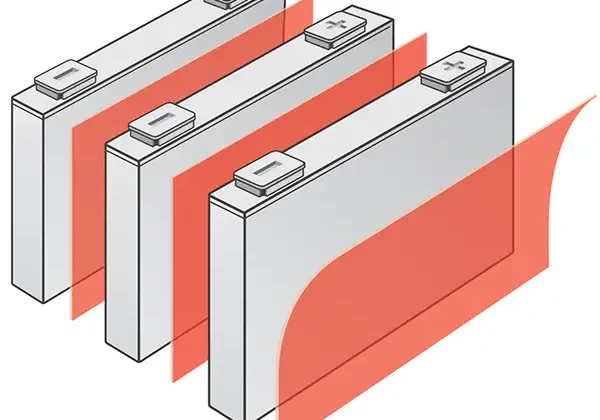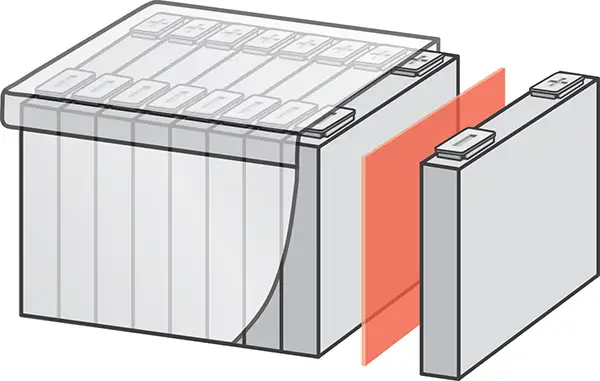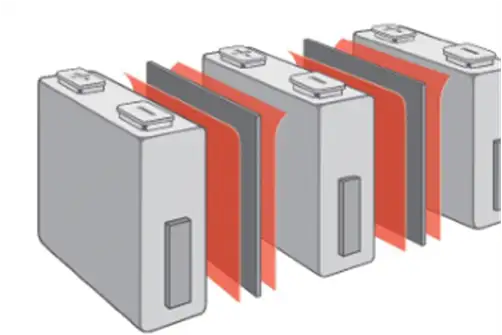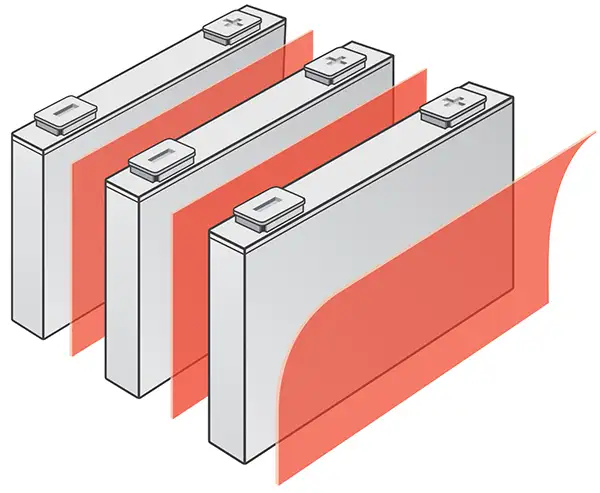
By Scott Krusinski, product mgr., Automotive and Other Transportation, Avery Dennison Performance Tapes
Automakers are investing heavily in electric-vehicle (EV) technology and are setting long-term goals for phasing out internal-combustion engines. This strategic shift is driven by increased lithium-ion (Li-ion) technology and product innovations extending the EV driving range and reducing battery-pack costs. The EV space is an area that will provide tremendous opportunities for converters and others working with high-performance, pressure-sensitive adhesive tapes. Converted p-s materials are used in a variety of EV-battery applications that enable those packs to be more efficient, safer and easier to assemble. Pressure-sensitive materials aid in solving some of the most common challenges facing those in the EV-battery value chain. The significant issues this article will address include how p-s adhesive (PSA) tapes help reduce flammability, boost dielectric strength, and optimize design and assembly.
Introduction
Electric-vehicle (EVs) sales turned a corner in 2020, and there is no turning back now. Electric-car sales rose from 2.2 million in 2019 to 3 million in 2020 [1], representing 4.1% of total car sales. In 2022, that growth accelerated as electric-car sales more than doubled to 7.8 million – close to 10% of the global car marketplace. Recent projections have light-duty EV sales reaching 28.7 million vehicles by 2030.
This represents a massive – and rapid – transformation in the automotive industry, and vehicle manufacturers are making the investments required to enable this change. In 2021, automakers announced more than $35 billion in electrification investments in North America [2], and then followed that up by announcing an additional $25 billion in the first half of 2022.
At the center of this transformation is the EV battery. As the industry ramps up its production of EVs, it is working across the value chain to improve the performance, ensure the safety and scale the production of EV batteries.
Pressure-sensitive materials are providing solutions to some of the most common challenges that automakers and battery manufacturers face in relation to EV batteries, including protecting against thermal runaway, reducing flammability, boosting dielectric strength and improving production efficiency.
Preventing thermal runaway
At certain voltages and temperatures, the liquid electrolytes in lithium-ion batteries can become volatile and catch fire. These incidents have been rare but, without proper thermal-runaway protection, can be dangerous and must be addressed through battery design to ensure consumers have confidence in the safety of EVs.
Thermal-runaway protection is being designed into EV batteries at multiple levels, including the cell and the pack. Pressure-sensitive adhesives and tapes have become one of the bonding solutions for thermal-runaway applications in cylinder and pouch-cell battery designs, which are common in North America.

In these EV battery types, thermal-runaway protection typically is provided by introducing a flame-retardant material, such as mica or ceramic fibers, around the pack and between the cells (see Figure 1). Specially designed PSAs meet the flame requirements that battery manufacturers are designing for these applications, including UL® 94 V-0.
Originally available in acrylic- and silicone-based formulations, adhesives that meet UL-94 V-0 and other flame requirements now are available in rubber-based formulations as well to support the increased use of LSE plastics in EV batteries. This allows use of UL 94 V-O-compliant adhesives with the full range of substrates found in today’s – and tomorrow’s – battery designs.
These adhesives can be paired with single- or double-sided polyester tape that also meets the UL-94 V-O standard to support thermal-runaway applications using fibrous flame-retardant materials (see Figure 2). In these applications, the tape not only effectively encapsulates the fibrous materials to prevent dusting but also adds dielectric strength. The use of easy-release liners is recommended to help prevent the cohesive failure of delicate fibrous-based materials.
While these solutions were developed to support thermal-runaway protection, they also are being used to reduce flammability in a host of other EV-battery applications.
Reducing flammability

One of the values pressure-sensitive tapes provide is their ability to address multiple challenges with a single solution. When used for cell-to-cell bonding or compression padding, flame-retardant adhesives and tapes can support effective bonding that does not introduce materials to the battery that provide fuel for a fire that already has started.
Compression pads are positioned between cells to protect them from damage due to impact or swelling (see Figure 1). Poron® and silicone foam commonly are used for cell padding. If reducing flammability is a key design concern, an adhesive such as this firm’s new acrylic can be used for applications using Poron and silicone for applications using silicone foam. General automotive adhesives may be used for this application, if flammability is less of a concern.
Boosting dielectric strength
Preventing arcing between metal components in compact, high-voltage EV batteries is a key design concern. When used for cell-to-cell bonding, pressure-sensitive tapes provide a quick and robust way to enhance structural integrity and boost dielectric strength in EV-battery packs using pouch and/or prismatic cells (see Figure 3). Newer conformable dielectric tapes can be especially valuable in this application.
Designed specifically for the EV-battery marketplace, single-sided conformable tape features improved stretching properties that allow better bonding with contoured and raised surfaces, and polyurethane facestock prevents electrical arcing. The tape uniformly maintains its thickness and conforms to sharp corners without splitting.
Tapes also bring significant space-saving benefits to electrical insulation and other EV-battery applications. Coatings will be at least 150 microns thick, while tapes can provide the same dielectric strength at half the thicknesses. In EV-battery design, every micron matters.
Enabling scalability

Pressure-sensitive materials can help manufacturers adapt to growth by improving production efficiency. P-s materials bond with no cure time and provide immediate strength that can act as an assembly aid. They eliminate the need for mixing nozzles or other equipment required by liquid coatings (see Figure 3).
They even can help manufacturers qualify for incentives included in the recent US Inflation Reduction Act. Beginning in 2024, 50% of the component parts in EV batteries must be produced or manufactured in the US, or one of 20 countries with a free trade agreement with the US, to qualify for consumer incentives.
Conclusion
With solutions such as new acrylic adhesives and conformable dielectric tapes, pressure-sensitive material manufacturers are keeping pace with the rapid innovation occurring in EV-battery design and continue to bring developments to market that meet the requirements of this fast-growing industry. As EV batteries continue to evolve, unknown needs and trials will emerge. To build effective and reliable solutions, OEMs, tier suppliers, converters and material manufacturers must work together to address new challenges and design requirements.
References
Scott Krusinski, product mgr., Automotive and Other Transportation for Avery Dennison Performance Tapes, can be reached at email: scott.krusinski@averydennison.com, www.tapes.averydennison.com.

